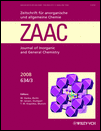Halogenide der Seltenerdmetalle Ln4X5Z. Teil 3: Das Chlorid La4Cl5B4 – Präparation, Struktur und Verwandtschaft zu La4Br5B4, La4I5B4
Abstract
Rare Earth Halides Ln4X5Z. Part 3: The Chloride La4Cl5B4 – Preparation, Structure, and Relation to La4Br5B4, La4I5B4
La4Cl5B4 is synthesized by reaction of LaCl3, La metal and boron in sealed Ta containers at 1050 °C < T < 1350 °C. It crystallizes in the monoclinic space group C2/m with a = 16.484(3) Å, b = 4.263(1) Å, c = 9.276(2) Å and β = 120.06(3)°. Ce4Cl5B4 is isotypic, a = 16.391(3) Å, b = 4.251(1) Å, c = 9.180(2) Å and β = 120.20(3)°. The La atoms form strings of trans-edge shared La octahedra, and the B atoms inside the strings form B4-rhomboids, which are condensed to chains via opposite corners. The Cl atoms interconnect the channels according to La2La4/2Cli−i6/2Cli−a2/2Cla−i2/2. The crystal structures of the bromide and the iodide are comparabel, however, the interconnection of the strings is different in the three structure types, as 14 Cl, 13 Br and 12 I atoms surround the La6 octahedra.




